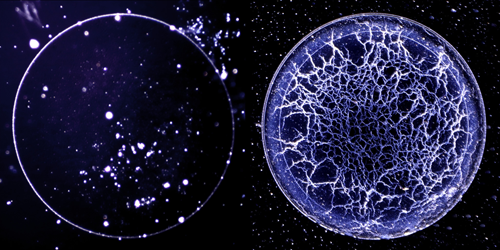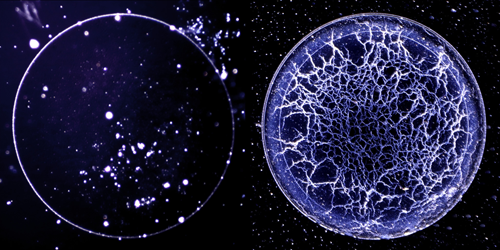Telling Whiskey from Whisky
Americans have whiskey and Scots have whisky, but more distinguishes the two liquors than mere spelling. Scotch whisky typically acquires its flavor while it ages in mature—often recycled—barrels, while American whiskey, such as bourbon, is aged in new, charred-oak barrels. Understanding what this means at the chemical level could help with spotting illegal counterfeits and suggest faster alternatives to traditional aging. Seeking such an understanding, Stuart Williams and colleagues at the University of Louisville in Kentucky—a state with twice as many barrels of aging whiskey as residents—has discovered a behavior unique to American whiskey that could lead to analytical tools for probing its chemistry. When evaporating from a surface, American whiskey leaves web-like patterns that aren’t observed with other liquors.
Inspired by a previous study on Scotch whisky (see 24 March 2016 Synopsis), Williams and colleagues tested the evaporation of drops with different liquor concentrations. As expected from the Scotch study, high concentrations left a uniform deposition layer, while severely diluted drops produced a “coffee-ring” pattern. At intermediate concentrations, however, the team saw structures reminiscent of the blood-vessel network of a human eye. After evaporating tens of whiskeys, whiskies, and other distillates, they found that only whiskey aged in new, charred barrels left these web-like patterns. Furthermore, each pattern was a unique, reproducible “fingerprint” of the whiskey type and age.
Using a qualitative model, the team argues that the patterns may derive from chemicals released when whiskey interacts with the charred barrel wood. These chemicals form agglomerates that collapse when the drop evaporates, leaving the signature residue. To test this hypothesis and pinpoint the responsible chemicals, the team next plans to place “tracer” molecules inside the drops, allowing them to make microscopic movies of the evaporation process.
This research is published in Physical Review Fluids.
–Matteo Rini
Matteo Rini is the Deputy Editor of Physics.





